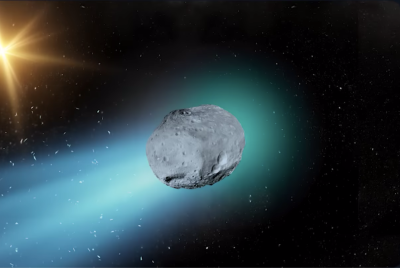Forget The 3i/ATLAS - The Largest Comet Coming To Earth Could Hit In 2029 With A 'Mean' Diameter Of 1,115 Ft
Rare Apophis approach and new 3I/ATLAS data spark global scientific interest

While the internet has been buzzing over the mysterious 3i/Atlas, with some even speculating it could be an alien spacecraft rather than a natural comet, astronomers say the real celestial event worth watching isn't that one at all — it's Apophis.
This massive near-Earth asteroid, measuring about 1,115 feet across, is expected to make an exceptionally close pass by Earth in 2029. Scientists are already gearing up for the rare encounter, hoping it will unlock new insights into how ancient space rocks behave and evolve as they journey through the solar system.
Apophis Will Make a Historic Close Approach
NASA confirms that asteroid Apophis will pass just 20,000 miles from Earth's surface on 13 April 2029. This distance is closer than many geosynchronous satellites, and it marks the closest predicted pass of an asteroid of this size in recorded history.
Researchers first noticed Apophis in 2004, and early calculations suggested a potential impact in future decades. As observations improved, astronomers refined the orbit and ruled out any danger for at least the next 100 years. With risk eliminated, the 2029 flyby has become one of the most anticipated scientific events of the decade.
Scientists Expect Physical Changes During the Flyby
As Apophis moves through Earth's gravitational field, it is expected to experience stretching, twisting and shifts in surface material. NASA explains that these forces will likely alter the asteroid's orbit and may change the speed and direction of its rotation. Loose material on steep slopes could also move, revealing details about its internal structure.
After completing its sample mission from asteroid Bennu, NASA redirected OSIRIS-REx toward Apophis. The spacecraft, now renamed OSIRIS-APEX, will rendezvous with the asteroid shortly after the flyby to capture high-resolution images and measure surface changes. The European Space Agency is preparing its own mission, called Ramses, which will accompany Apophis as it passes by Earth.
These combined missions will allow scientists to record how an asteroid responds when it passes through a gravitational field at such close range. This information will help researchers understand the structure, stability and long-term behaviour of similar objects.
What Apophis Is Made Of and How It Formed
Apophis is an S-type asteroid composed of silicate rock with nickel and iron. Radar imaging suggests a stretched, peanut-like shape with two distinct lobes. NASA notes that the asteroid likely originated in the main belt between Mars and Jupiter before drifting inward over millions of years.
The asteroid rotates end-over-end roughly every 31 hours and has a secondary, slower rocking motion. Researchers expect these rotations to shift during the flyby, helping scientists learn more about its density and internal structure.
New Findings From Interstellar Comet 3I/ATLAS
As Apophis prepares for its close pass, astronomers are also studying new data from the interstellar comet 3I/ATLAS. Scientists recently detected radio emissions linked to hydroxyl radicals forming in the comet's coma. These signals appear when sunlight breaks down water molecules, which confirms natural cometary activity.
The detection initially fuelled renewed speculation among fringe theorists who claim the comet may have artificial origins. Researchers state that every observation proves the opposite, as 3I/ATLAS displays classic traits of natural comet behaviour. These include water outgassing, a bright tail, a temporary colour change near perihelion and shifting features as it moved behind the Sun.
Astronomers continue to monitor the comet as it travels through the solar system, using the data to understand how interstellar objects behave when they pass through the Sun's influence.
A Rare Moment for Planetary Science
The attention surrounding Apophis and 3I/ATLAS highlights how active planetary science has become. Apophis will be visible to the naked eye in parts of the Eastern Hemisphere during its flyby, offering the public a rare chance to witness an event not previously recorded in human history.
As 2029 draws closer, scientists expect a surge in data that will reveal new details about asteroid composition, orbital dynamics and the broader story of how the solar system formed.
© Copyright IBTimes 2025. All rights reserved.




















